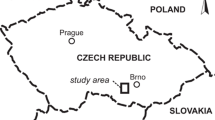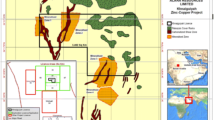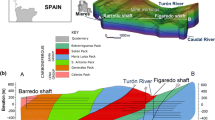Abstract
A two-dimensional model is presented as a way to hydrogeologically characterize the controlling factors in the Sanshandao Gold Mine. The finite element method was first applied to simulate the ground water system of the current operation, using leakage data and the calculated recharge. An inverse model was applied to the observed data (e.g., head and discharge) to verify and calibrate the ground water simulation model and to estimate the hydrogeological parameters for the water-bearing zones. Nonlinear mathematic programming was used to solve the inverse model and to estimate the model parameters in 17 districts with different hydrogeological characteristics. The finite element equations were solved by means of a large non-symmetrical sparse equation. The results were in agreement with what is currently observed in the mine. The models and the estimated parameters were then applied to predict the mine water discharge for drifts extending to depths of −330 to −600 m during the next development stage. In order to improve the predicted accuracy of the numerical model, an iterative element mesh was added in the districts near the drainage drifts so that the computed discharges that flowed into the drifts would approach the recharges that flow into the borders of the mine. The model was also used to understand how the mine discharge would be influenced by factors such as unsteady ground water flow and the construction of hydraulic barriers to restrict ground water from entering the pits.

Similar content being viewed by others
References
Chang S, Yue WWG (1976) A proposed algorithm for the solution of the large-scale inverse problem in ground water. Water Resour Res 12:365–374
Chen Y (1986) Groundwater movement and water resource evaluation (in Chinese). China Construction Industry Press, Beijing, p 193
Larabi A, Smedt FD (1994) Solving three-dimensional hexahedral finite element ground water models by preconditioned conjugate methods. Water Resour Res 30:509–521
Liu CP (1995) The optimal model of planning and management for ground water system (in Chinese). Zhongnan University Press, Changsha, pp 219–243
Liu CP, Bo P, Jianxin Q (2007) Geological analysis and numerical modeling of mine discharges for the Sanshandao Gold Mine in Shandong, China: 1. Geological Analysis. Mine Water Environ (in press)
Liu CP, Zheng CC (1994) Optimization estimation method of multiple types of hydrogeologic parameters (in Chinese). Geo-tech Invest Surv 2:33–37
Liu DG, Fei JG, Yu YJ (1980) A compilation of FORTRAN algorithms, vol 1 (in Chinese). Defense Industry Press, Beijing, pp 101–104
Xu SH, Zu XY (1999) Hydraulic capture technique for remedy of ground water contaminate by petroleum and its numerical model (in Chinese). J Hydraul Eng 1:71–76
Xue YQ, Xie CH, Wu JC (1991) A numerical model of the seawater intrusion in coastal aquifer. In: Xue YQ, Bear J (eds) Proceedings of international conference on modeling ground water flow and pollution. Nanjing University Press, Nanjing, pp 13–20
Xue YQ, Zhu XY, Wu JC (1986) Ground water dynamics (in Chinese). Geology Press, Beijing, pp 213–217
Yeh WWG (1981) On the computation of Galerkin velocity and mass balance: The finite element modeling of ground water flow. Water Resour Res 17:1529–1534
Yeh WWG (1986) Review of parameter identification procedures in ground water hydrology: the inverse problem. Water Resour Res 22:95–108
Acknowledgments
This work was funded by a grant from the Changsha Institute of Mine and was a key project of the Hunan Education Administration.
Author information
Authors and Affiliations
Corresponding author
Additional information
Part 1 of this article can be found at doi:10.1007/s10230-007-0004-6.
Rights and permissions
About this article
Cite this article
Liu, C., Peng, B. & Qin, J. Geological Analysis and Numerical Modeling of Mine Discharges for the Sanshandao Gold Mine: 2. Simulation and Prediction of Mine Discharges. Mine Water Environ 26, 166–171 (2007). https://doi.org/10.1007/s10230-007-0005-5
Received:
Accepted:
Published:
Issue Date:
DOI: https://doi.org/10.1007/s10230-007-0005-5




